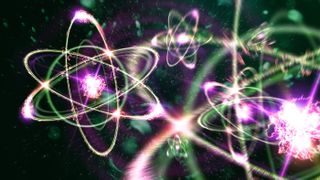Scientists get rare glimpse of 'nesting doll' isotope nitrogen-9
With five more protons than should be stable, the newly discovered nitrogen-9 isotope sits right on the borderline of physical possibility.

Scientists may have just caught their first glimpse of an ultra-rare version of nitrogen containing five more protons than it can stably hold.
Scientists discovered hints of the new isotope, called nitrogen-9, by smashing beams of oxygen isotopes into beryllium atoms in the U.S. National Superconducting Cyclotron Laboratory.
If follow-up experiments can confirm its existence, the isotope will set a new record for an atomic nucleus with the highest number of extra protons — moving the number from four to five. The researchers described the strange new isotope Oct. 27 in the journal Physical Review Letters.
Related: Scientists discover 1st 'neutron-rich' isotope of uranium since 1979
The ultra-unstable version of nitrogen decays like a Russian nesting doll, sequentially emitting one or two protons while revealing the next set, Robert Charity, a nuclear scientist at Washington University in St. Louis, said in a statement.
Protons and neutrons are held together inside atomic nuclei by the strong force, a glue which in stable atoms overpowers the repulsive force of positively-charged protons pushing against each other. But add more protons and this balance eventually tips — moving atoms beyond the so-called "drip line."
Beyond the drip line atoms become unstable, and decay by chucking out protons or neutrons. Because they exist on the furthest edge of possible atomic nuclei, semi-stable atoms beyond the drip line (which come in the form of rare isotopes) have long fascinated nuclear scientists.
"The existence of such an exotic system is a good test of the quantum mechanics of open or unbound many-body systems," Charity said.
The researchers found the first hints of nitrogen-9’s presence in data from a years-old experiment conducted by the National Superconducting Cyclotron Laboratory. Originally, the scientists smashed oxygen-13 atoms into beryllium in a bid to create another isotope called oxygen-11.
But lurking among the millions of interactions was another decay signature that pointed to something else. Right on the borderline of statistical significance, the researchers spotted rare atoms of nitrogen-9 popping into existence for just 10^-21 seconds.
To get partial confirmation they had found the weird isotope, the scientists modeled the isotope’s structure, finding that it consisted of a helium nucleus with two protons and two neutrons surrounded by five loosely held protons. After the briefest slice of time the protons decayed, successively escaping the nucleus through a quantum tunnel.
Further experiments will be needed to confirm the discovery. They remain hopeful that, when they do, the isotope will help them to piece together the decay paths more common isotopes take to come into existence.
"The elements we have around us are made via a set of mechanisms that work through intermediates that we do not have around us," Lee Sobotka, a professor of chemistry and physics at Washington University, said in the statement. "These intermediates are unstable and often have highly unusual neutron-to-proton ratios. Our work involves both reconstructing the structure of, and reactions producing, such nuclei."
Live Science newsletter
Stay up to date on the latest science news by signing up for our Essentials newsletter.

Ben Turner is a U.K. based staff writer at Live Science. He covers physics and astronomy, among other topics like tech and climate change. He graduated from University College London with a degree in particle physics before training as a journalist. When he's not writing, Ben enjoys reading literature, playing the guitar and embarrassing himself with chess.
-
drdan Because the writer is apparently clueless about the subject matter he is writing about. Thankfully, an AI bot could output more meaningful prose. Just wasted 5 min of my life reading and responding to this off wally nonsense, shame on him.Reply -
One-Two Reply
After reading some more articles on this. It is a nitrogen atom only holding on to 2 neutrons, to be stable with two neutrons it should be a helium atom (2) protons, but for some reason it is able to retain 5 more protons than that. It is written/ explained strangely and makes it seem nonsensical at first and second glance.drdan said:Because the writer is apparently clueless about the subject matter he is writing about. Thankfully, an AI bot could output more meaningful prose. Just wasted 5 min of my life reading and responding to this off wally nonsense, shame on him.
Most Popular

By Emma Bryce
